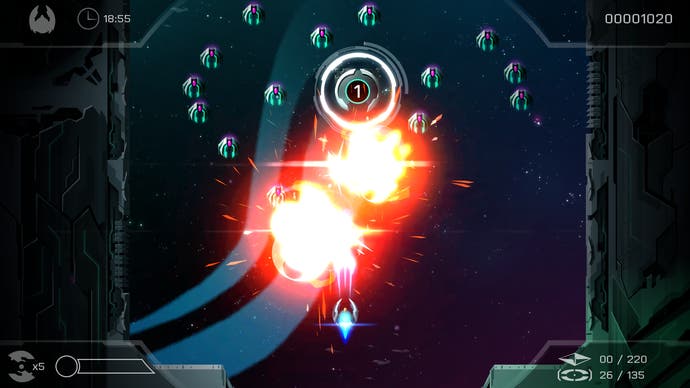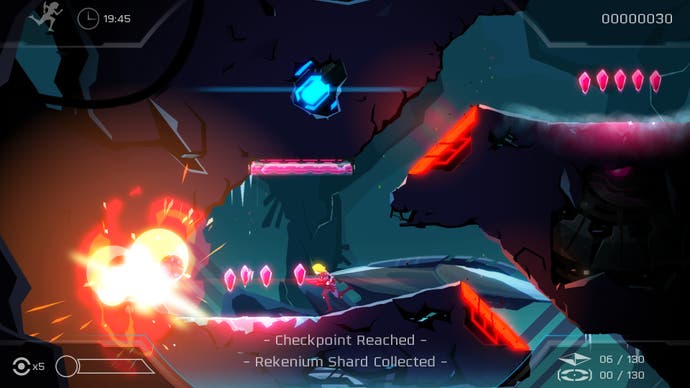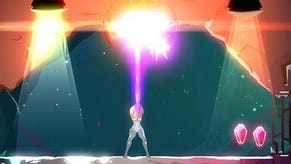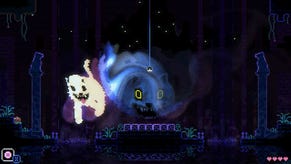Velocity 2X review
Space hopper.
One of Sony Computer Entertainment's home-grown techniques for discovering new types of video game is to drop a number of pieces of paper into a hat, each bearing the name of a different genre or classic game. After these slips are mixed together, a hopeful designer plunges a hand in and draws out two of the names. The idea is that the combinations open up previously unimagined creative pathways to invention and novelty. "Gran Turismo" and "Real-Time Strategy" perhaps. "Minecraft" and "League of Legends". "Dark Souls" and "Dance Dance Revolution". Sony claims this unorthodox approach has influenced a number of projects across the years.
Whether Velocity 2X is the product of this kind of serendipitous matchmaking is unclear, but this nippy shoot-'em-up bears the scars of creative splicing.
Everything that made the original Velocity such a rare, twitch treat remains intact. The stark arcade space-game styling retains its Xenon-esque elegance - albeit in pin-sharp HD. The brusque stream of bullets that streaks from the nose of your ship (known as the Quarp Jet) is familiarly quick and precise, while the teleportation mechanic that allows you to flit and blink around the screen, across barriers and into silos, will be second nature to Velocity vets.

All of this is still delivered at an unwavering 60 frames per second, smearing the stars across your television screen every time you squeeze the throttle in order to quicken your dash past the finishing line of each of its 50 stages.
But now 'shoot-'em-up' is only half the story. The space dash is now interrupted as your pilot, fair-haired Lieutenant Kai Tana, regularly docks at a space station and continues on foot in order to solve puzzles, which unlock otherwise-impassable gates for the awaiting Quarp Jet. These sections, some of which last for a few minutes as you wend your way through a complicated network of sterile rooms and chambers, have their own rhythm and pace. The clock, meanwhile, continues to count up regardless of whether you're racing through spaceport grime or space.
The switch between the two modes of play is slick but not entirely seamless. There is a mild sense of disorientation when moving between two distinct control schemes in a game in which the emphasis is on high-speed manoeuvring. There's no time to adjust the mind. In the spaceship, for example, the X button fires your weapon. As soon as you go on foot, the X button performs a slide (necessary for slipping under low-hanging ceilings) while the right analogue stick fires your gun. Hit the wrong button at the wrong moment and it will cost valuable seconds and score.
It's not that either control method is incorrect; both are entirely well-suited to their own contexts. But switching between them at high speed is like trying to shout a set of urgent instructions while alternating between French and Spanish - it takes a while to get the hang of it and never feels entirely natural.

Eventually you learn to slip between each set of vocabulary with ease - but it's a surprisingly steep learning curve for a game that's ostensibly straightforward. There's also a sense that developer FuturLab, in its eagerness to expand the Velocity vision to PlayStation 4 proportions, has overcomplicated things a little. As well as the scientists you must rescue floating about in space, you also collect crystals inside the space stations, shoot multiple types of weapon (none of which are quite distinct enough from one another), and shoot numbered, colour-coded locks in sequence in order to unlock routes through each stage. The increasingly complicated stage designs at some level work against the game's driving imperative to be quick, be precise and, wherever possible, to enter a flow state.
There are, however, numerous flourishes of design. One of the game's most interesting mechanics is the telepods, introduced in its latter half. On foot telepods are devices that can be hurled like a grenade and then used to teleport Lt. Tana to their position (even while in mid-air). You may, for example, aim the telepod through a narrow and deadly passage before teleporting to its final landing place in the next room. In space the telepod takes a slightly different form, more like a checkpoint in the environment to which you may later return at any point.
To make use of the device the designers introduce branching pathways. Before you choose a path, you drop a telepod, and when you've plundered one area you must return to the branch and continue down the other route. The only problem is that should you forget to drop a telepod, or place it incorrectly, you will be unable to progress in a level and forced to quit via the menu screen - an inelegant, if unavoidable side effect of the design. To help ensure you always drop a telepod in the correct place, the screen will flash blue at the appropriate juncture, but it's still possible to miss the prompt.

These complexities (and the staccato rhythm of play they inspire, as you trip over your thumbs or lose your sense of positioning) may turn some players off. But the game amply rewards dedication. As with all the best twitch arcade-style games, there is discernible progress and refining of technique the longer you spend within its bounds. The designers continually surprise too, with boss battles, speed-quickening ramps, enemies that can only be toppled by 'teledashing' through them, as well as a raft of other interest-maintaining conceits. You will need to improve, too, as the game only unlocks new stages when you collect the requisite number of experience points, awarded for completing levels quickly, comprehensively or with a particular high score.
A short cut-scene introduces each of the game's 50 stages and these are notably well-written. But the game has already put its player in a rush state; few will bother to read about Lt. Tana's exploits when a sharp stab of the button will propel you into a sugar-rush space sprint. For those who resist the urge to hurry, however, Velocity tells a good tale, and one that imbues all the dashing through space with a different kind of urgency and appeal.
Despite the game's dipped-nose poise, its obsession with speed and clocks, it rewards those who take their time, who perfect their technique on each stage, and who savour an arcade game that's been lovingly embellished and expanded to its full and likely final potential.











